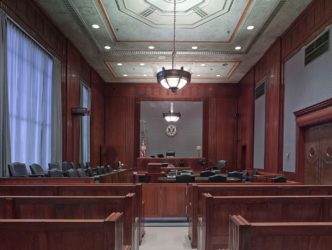Technology in the court room, like the state-of-the-art court reporting technology used by Court Scribes, enhances the accuracy of legal transcripts and court cases.
 Court reporters document millions of court cases with transcripts each year, and 14 states allow the use of audio or video recorders in place of court reporters, according to a 2015 study by the National Center for State Courts, The Marshall Project reported.
Court reporters document millions of court cases with transcripts each year, and 14 states allow the use of audio or video recorders in place of court reporters, according to a 2015 study by the National Center for State Courts, The Marshall Project reported.
Many have made the move to reduce rising costs in their court systems.
The project reports that according to a 2009 Iowa Judicial Council study, the state could save more than $10 million a year in court reporter salaries by going to a digital recording system. Utah eliminated court reporters almost entirely in 2009, saving $1.3 million a year, according to a 2012 study conducted by the NCSC and the State Justice Institute.
The Iowa Council’s study found that at the time, speech to text dictation was “not sufficiently advanced” to handle court transcription, but since then, court reporting technology has dramatically improved although dialects and accents and conversational speech can still be challenging.
“When you talk to Alexa you are mostly using the same five sentences. Turn the light off, or order me this. Play this song,” said Gerald Friedland, an adjunct associate professor in electrical engineering and computer science at the University of California, Berkeley. “The moment you go from humans talking to computers to humans talking to humans, things get much harder.”
Audio tapes of trials are very beneficial when a written transcription is contested, or a lawyer has a particular portion that they want to hear again complete with the inflection of the speaker.
But the Project found that transcripts made from audio recordings are rarely changed. For example, in Connecticut, which uses audio recordings, only 30 of 17,000 transcripts were challenged for a perceived discrepancy between the written record and the audio recording. Of those requests, revisions ultimately only made in 13 of the cases.
Drew Findling, president of the National Association of Criminal Defense Lawyers, said the question is not whether court reporting technology is better than human court reporters, but about whether the defendant is getting a fair trial. For example, court reporters can read back something that was said in real-time if there’s a question.

 Plaza College
Plaza College Although s
Although s A court reporting student who gets a degree at MacCormac is likely to come out with about $30,000 in debt but will likely get a job paying at least $40,000 annually, Forbes said.
A court reporting student who gets a degree at MacCormac is likely to come out with about $30,000 in debt but will likely get a job paying at least $40,000 annually, Forbes said.